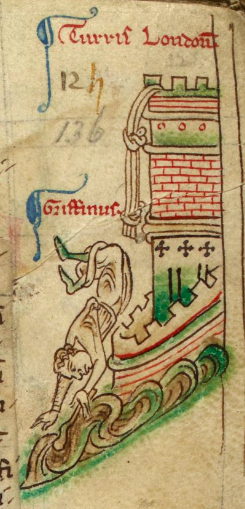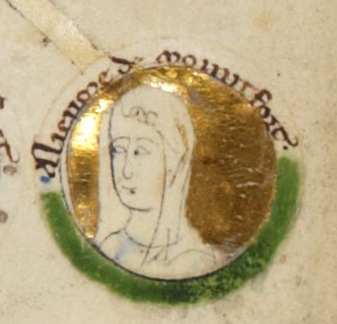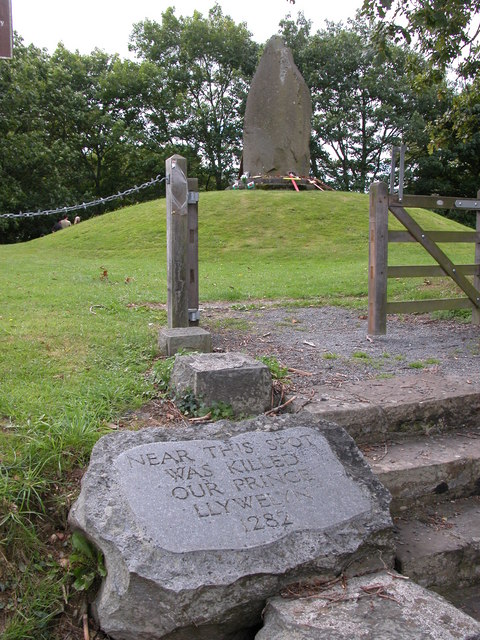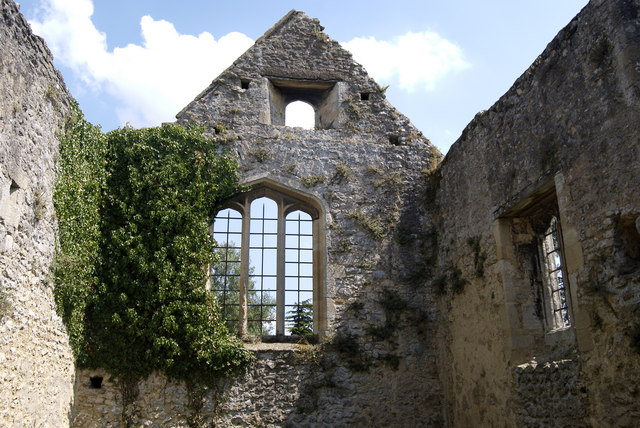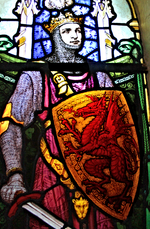by Susan Flantzer
© Unofficial Royalty 2024
Wales was divided into several separate kingdoms. The largest of these was Gwynedd in northwest Wales and Powys in east Wales. Gwynedd was the most powerful of the Welsh kingdoms. For one man to rule all of Wales during this period was rare. This was because of the inheritance system practiced in Wales. All sons received an equal share of their father’s property, including illegitimate sons, resulting in the division of territories.
The Principality of Wales was created in 1216 at the Council of Aberdyfi when it was agreed by Llywelyn the Great and the other Welsh princes that he was the paramount Welsh ruler and the other Welsh princes would pay homage to him. Although he never used the title, Llywelyn was the de facto Prince of Wales. Llywelyn dominated Wales for 45 years and was one of only two Welsh rulers to be called “the Great”, the other being his ancestor Rhodri the Great. Llywelyn was succeeded by his son Dafydd ap Llywelyn and then by his two grandsons who were the sons of his illegitimate son Gruffydd ap Llywelyn.
The campaign of King Edward I of England in Wales (1276 – 1284) resulted in Wales being completely taken over by England. It ended with the deaths of the last two native Princes of Wales: Llywelyn ap Gruffudd who was ambushed and killed in 1282 and his brother Dafydd ap Gruffydd, who was the first prominent person in recorded history to have been hanged, drawn, and quartered, in 1283. To ensure there would be no further members of the House of Aberffraw, the English imprisoned Dafydd ap Gruffydd’s two young sons for the rest of their lives at Bristol Castle and sent his daughter and the daughter of his brother Llywelyn ap Gruffydd to convents. To further humiliate the Welsh, King Edward I invested his son and heir, the future King Edward II, with the title Prince of Wales. Since then, the title has been granted (with a few exceptions) to the heir apparent of the English or British monarch.
Note: In Welsh, “ap” means “son of” and “ferch” means “daughter of”.
*********************

Coat of Arms of Elizabeth Ferrers’ husband, Dafydd ap Gruffydd, Prince of Wales; Credit – By Sodacan Own work, CC BY-SA 3.0, https://commons.wikimedia.org/w/index.php?curid=12219418
Born circa 1240, in Derby, Derbyshire, England, Lady Elizabeth Ferrers, from an English noble family, was the wife of Dafydd ap Gruffydd, the last native and independent Prince of Wales. She was the youngest of the five children and the youngest of the three daughters of William de Ferrers, 5th Earl of Derby and his second wife Margaret de Quincy. Elizabeth’s paternal grandparents were William de Ferrers, 4th Earl of Derby and Agnes de Kevelioc. Her maternal grandparents were Roger de Quincy, 2nd Earl of Winchester, and Helen of Galloway.
Elizabeth had four elder siblings:
- Robert de Ferrers, 6th Earl of Derby (1239 – 1279), married (1) Mary de Lusignan, no children (2) Eleanor de Bohun, had two children
- William de Ferrers of Groby (1240 – 1287), married (1) Anne Durward, had one son (2) Eleanor de Lovaine, no children
- Joan de Ferrers (circa 1248 – 1309), who married Thomas de Berkeley, 1st Baron Berkeley, had seven children
- Agnes de Ferrers (circa 1252 – circa 1313), married (1) Sir Robert de Musgrove of Kemerton, Boddington & Deerhurst, no children (2) John FitzReginald, no children
Elizabeth had seven half-sisters from her father’s first marriage to Sybil Marshal:
- Agnes de Ferrers (circa 1222 – 1290), married William de Vesci, had five children
- Isabel de Ferrers (1226 – circa 1260), married (1) Gilbert Basset of Wycombe, no children (2) Reginald II de Mohun, had three children
- Maud de Ferrers (circa 1228- 1298), married (1) Simon de Kyme, no children (2) William de Vivonne, had four daughters (3) Amaury IX, Viscount of Rochechouart, had one daughter
- Sibyl de Ferrers (1230 – 1273), married (1) Frank de Bohun of Midhurst, had three children
- Joan de Ferrers (circa 1233 – 1267), married (1) Sir John de Mohun, Master of Dunster, had one son (2)Sir Robert II Aguillon of Addington, had one daughter
- Agatha de Ferrers (? – 1306), married Hugh Mortimer, had three children
- Eleanor de Ferrers (circa 1236 – 1274) married (1) William de Vaux, no children (2) Roger de Quincy, 2nd Earl of Winchester, no children(3) Roger de Leybourne, had two children
Elizabeth’s father William de Ferrers, 5th Earl of Derby had been in poor health for many years and died when Elizabeth was about fourteen years old. About 1256, Elizabeth was married to Sir William Marshal, 2nd Baron Marshal in Hingham, Norfolk, England. He was about twenty-five years older than Elizabeth and she was his second wife. The couple had no children. Willam died on August 4, 1265, at the Battle of Evesham. Soon after her first husband’s death, Elizabeth married Welsh Prince, Dafydd ap Gruffydd. He was the youngest of the four sons of Prince Gruffydd ap Llywelyn and Senana ferch Caradog. Dafydd’s paternal grandfather was the powerful Llywelyn ap Iorwerth, Prince of Gwynedd, also known as Llywelyn Fawr (Llywelyn the Great). At the time of their marriage, Dafydd ap Gruffydd’s elder brother Llywelyn ap Gruffydd was the Prince of an independent Wales.
Dafydd and Elizabeth had two sons and one daughter, and all were ill-fated:
- Llywelyn ap Dafydd (circa 1267 – 1287)
- Owain ap Dafydd (circa 1275 – circa 1325)
- Gwladys ferch Dafydd (? – 1336)
From 1277 – 1283, King Edward I of England had many military campaigns that ultimately resulted in the conquest of Wales. On December 11, 1282, Dafydd’s brother Llywelyn ap Gruffydd, Prince of Wales, was one of 3,000 Welshmen killed by the English army under King Edward I at the Battle of Orewin Bridge near Builth Wells, Wales. As Llywelyn ap Gruffydd, Prince of Wales only had an infant daughter, Dafydd ap Gruffydd took over as his brother’s legitimate successor and became Prince of Wales and leader of the resistance against King Edward I of England.
King Edward I’s massive army surrounded the Snowdonia base of Dafydd ap Gruffudd, Prince of Wales, who had limited manpower and equipment. Dafydd kept moving and finally, in May 1283, he was forced to move to the mountains above the Welsh royal home in Abergwyngregyn. On June 22, 1283, Dafydd and his younger son Owain ap Dafydd were captured and brought to King Edward I’s camp in Rhuddlan, Wales that same day. Dafydd was taken to Shrewsbury, England. Dafydd’s wife Elizabeth, their daughter Gwladys, their infant niece Gwenllian ferch Llywelyn were also captured. Elizabeth and Dafydd’s elder son Llywelyn ap Dafydd was captured on June 28, 1283. On that same day, King Edward I issued writs to summon a parliament to meet at Shrewsbury, to discuss Dafydd’s fate.
On September 30, 1283, Dafydd ap Gruffydd, Prince of Wales, was condemned to death, the first person known to have been tried and executed for high treason against an English king. King Edward I’s sense of outrage was so extreme that he designed a punishment for Dafydd harsher than any previous form of capital punishment. Dafydd ap Gruffydd was the first person in recorded history to have been hanged, drawn, and quartered. On October 3, 1283, Dafydd ap Gruffydd, Prince of Wales was dragged through the streets of Shrewsbury, England attached to a horse’s tail, then hanged alive, revived, then disemboweled and his entrails burned before him. He was then beheaded and his body was cut into four quarters. Dafydd’s four quarters were sent to different parts of England: the right arm to York, the left arm to Bristol, the right leg to Northampton, and the left leg to Hereford. His head was placed on a pole in the Tower of London near the head of his brother Llywelyn. The days of an independent Wales were over.
King Edward I of England wanted to make sure that there were no more claimants to the Welsh throne. Elizabeth and Dafydd ap Gruffydd’s young daughter Gwladys ferch Dafydd was sent to the Sixhills Convent in Sixhills, Lincolnshire, England, where she spent the rest of her life, dying circa 1336. King Edward I ordered an annual payment of 20 pounds for Gwladys’s upkeep.
Elizabeth and Dafydd ap Gruffydd’s two sons 15-year-old Llywelyn ap Dafydd and 7-year-old Owain ap Dafydd were imprisoned for the rest of their lives at Bristol Castle in England. Much of the time they were kept in cages. Llywelyn died in 1287, under mysterious circumstances, when he was about twenty years old. Owain was last reported to be alive in 1325 when he would have been in his fifties.
Gwenllian ferch Llywelyn, the 18-month-old daughter and only child of Llywelyn ap Gruffydd, Dafydd’s brother, was confined at Sempringham Priory in Sempringham, Lincolnshire, England where she lived until her death on June 7, 1337, a few days before her 55th birthday. An annual payment of 20 pounds was also arranged for Gwenllian’s upkeep.

St. Michael’s Church in Caerwys, Flintshire, Wales where Elizabeth may be buried; Credit – By Llywelyn2000 – Own work, CC BY-SA 4.0, https://commons.wikimedia.org/w/index.php?curid=62808423
As for Elizabeth Ferrers, Princess of Wales, her fate is uncertain. She lost everything and would never see her children again. Some historians think she returned to England and died circa 1297. It is possible that she was buried at St. Michael’s Church in Caerwys, Flintshire, Wales where there is a stone effigy reputed to be that of Elizabeth Ferrers.
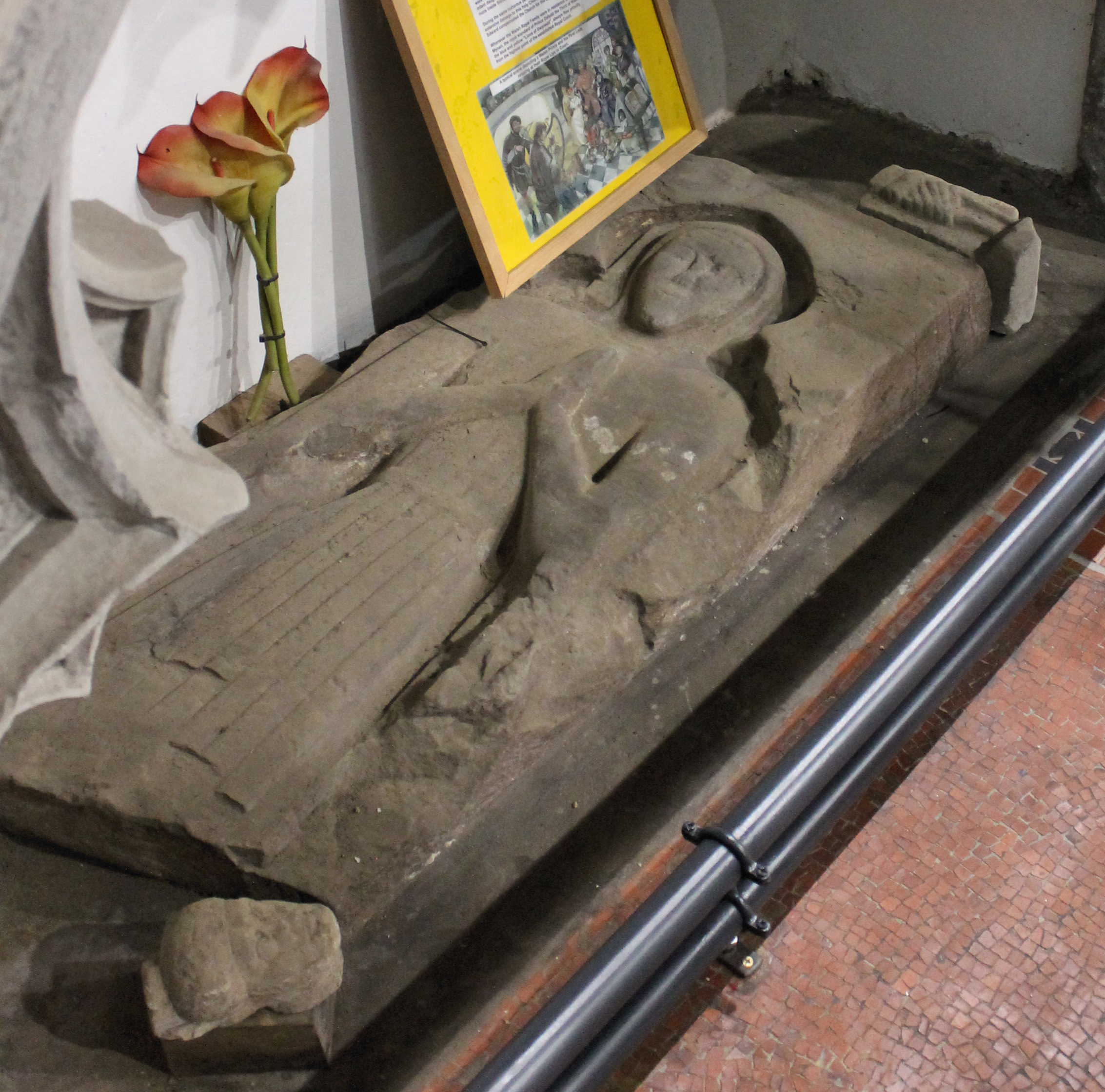
Effigy reputed to be that of Elizabeth Ferrers; Credit – Wikipedia
This article is the intellectual property of Unofficial Royalty and is NOT TO BE COPIED, EDITED, OR POSTED IN ANY FORM ON ANOTHER WEBSITE under any circumstances. It is permissible to use a link that directs to Unofficial Royalty.
Works Cited
- Belfrage, Anna Belfrage. (2018). Elizabeth who? A reflection on the life of a medieval woman. https://www.annabelfrage.com/2018/05/27/elizabeth-who/
- Flantzer, Susan. (2024). Dafydd ap Gruffydd, Prince of Gwynedd. Unofficial Royalty. https://www.unofficialroyalty.com/dafydd-ap-gruffydd-prince-of-wales/
- Sir William Marshall. geni_family_tree. (2023). https://www.geni.com/people/Sir-William-Marshall/6000000003828319213
- Wikimedia Foundation. (2023). Elizabeth Ferrers. Wikipedia. https://en.wikipedia.org/wiki/Elizabeth_Ferrers
- Wikimedia Foundation. (2021). Elizabeth Ferrers. Wikipedia (Welsh). https://cy.wikipedia.org/wiki/Elizabeth_Ferrers
- Wikimedia Foundation. (2022). William de Ferrers, 5th Earl of Derby. Wikipedia. https://en.wikipedia.org/wiki/William_de_Ferrers,_5th_Earl_of_Derby
- William de Ferrers, 5th Earl of Derby. geni_family_tree. (2023). https://www.geni.com/people/William-de-Ferrers-5th-Earl-of-Derby/6000000002092684088
- Williamson, David. (1996). Brewer’s British Royalty: A Phrase and Fable Dictionary. Cassell.

